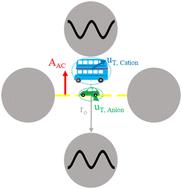Our official English website, www.x-mol.net, welcomes your feedback! (Note: you will need to create a separate account there.)
Ion parking in native mass spectrometry
Analyst ( IF 4.2 ) Pub Date : 2024-04-11 , DOI: 10.1039/d4an00242c Nicolas J. Pizzala 1 , Jay S. Bhanot 1 , Ian J. Carrick 1 , Eric T. Dziekonski 1 , Scott A. McLuckey 1
Analyst ( IF 4.2 ) Pub Date : 2024-04-11 , DOI: 10.1039/d4an00242c Nicolas J. Pizzala 1 , Jay S. Bhanot 1 , Ian J. Carrick 1 , Eric T. Dziekonski 1 , Scott A. McLuckey 1
Affiliation

|
A forced, damped harmonic oscillator model for gas-phase ion parking using single-frequency resonance excitation is described and applied to high-mass ions of relevance to native mass spectrometry. Experimental data are provided to illustrate key findings revealed by the modelling. These include: (i) ion secular frequency spacings between adjacent charge states of a given protein are essentially constant and decrease with the mass of the protein (ii) the mechanism for ion parking of high mass ions is the separation of the ion clouds of the oppositely-charged ions with much less influence from an increase in the relative ion velocity due to resonance excitation, (iii) the size of the parked ion cloud ultimately limits ion parking at high m/z ratio, and (iv) the extent of ion parking of off-target ions is highly sensitive to the bath gas pressure in the ion trap. The model is applied to ions of 17 kDa, 467 kDa, and 2 MDa while experimental data are also provided for ions of horse skeletal muscle myoglobin (≈17 kDa) and β-galactosidase (≈467 kDa). The model predicts and data show that it is possible to effect ion parking on a 17 kDa protein to the 1+ charge state under trapping conditions that are readily accessible with commercially available ion traps. It is also possible to park β-galactosidase efficiently to a roughly equivalent m/z ratio (i.e., the 26+ charge state) under the same trapping conditions. However, as charge states decrease, analyte ion cloud sizes become too large to allow for efficient ion trapping. The model allows for a semi-quantitative prediction of ion trapping performance as a function of ion trapping, resonance excitation, and pressure conditions.
中文翻译:

原生质谱中的离子停泊
描述了使用单频共振激励的气相离子停泊的强制阻尼谐振子模型,并将其应用于与天然质谱相关的高质量离子。提供实验数据来说明建模揭示的主要发现。这些包括:(i)给定蛋白质的相邻电荷态之间的离子长期频率间距基本上是恒定的,并且随着蛋白质的质量而减小(ii)高质量离子的离子停泊机制是蛋白质的离子云的分离。带相反电荷的离子由于共振激发而受到相对离子速度增加的影响要小得多,(iii) 停泊离子云的大小最终限制了高m / z比下的离子停泊,以及 (iv) 离子的范围脱靶离子的滞留对离子阱中的浴气压高度敏感。该模型适用于 17 kDa、467 kDa 和 2 MDa 的离子,同时还提供了马骨骼肌肌红蛋白 (≈17 kDa) 和 β-半乳糖苷酶 (≈467 kDa) 离子的实验数据。该模型预测和数据表明,在捕获条件下,可以将 17 kDa 蛋白质上的离子停泊至 1 +电荷态,而这种捕获条件可通过市售离子阱轻松实现。在相同的捕获条件下,还可以将β-半乳糖苷酶有效地停放至大致相等的m / z比(即26+电荷态)。然而,随着电荷状态的减少,分析物离子云尺寸变得太大而无法进行有效的离子捕获。该模型允许根据离子捕获、共振激发和压力条件对离子捕获性能进行半定量预测。
更新日期:2024-04-11
中文翻译:

原生质谱中的离子停泊
描述了使用单频共振激励的气相离子停泊的强制阻尼谐振子模型,并将其应用于与天然质谱相关的高质量离子。提供实验数据来说明建模揭示的主要发现。这些包括:(i)给定蛋白质的相邻电荷态之间的离子长期频率间距基本上是恒定的,并且随着蛋白质的质量而减小(ii)高质量离子的离子停泊机制是蛋白质的离子云的分离。带相反电荷的离子由于共振激发而受到相对离子速度增加的影响要小得多,(iii) 停泊离子云的大小最终限制了高m / z比下的离子停泊,以及 (iv) 离子的范围脱靶离子的滞留对离子阱中的浴气压高度敏感。该模型适用于 17 kDa、467 kDa 和 2 MDa 的离子,同时还提供了马骨骼肌肌红蛋白 (≈17 kDa) 和 β-半乳糖苷酶 (≈467 kDa) 离子的实验数据。该模型预测和数据表明,在捕获条件下,可以将 17 kDa 蛋白质上的离子停泊至 1 +电荷态,而这种捕获条件可通过市售离子阱轻松实现。在相同的捕获条件下,还可以将β-半乳糖苷酶有效地停放至大致相等的m / z比(即26+电荷态)。然而,随着电荷状态的减少,分析物离子云尺寸变得太大而无法进行有效的离子捕获。该模型允许根据离子捕获、共振激发和压力条件对离子捕获性能进行半定量预测。



























 京公网安备 11010802027423号
京公网安备 11010802027423号